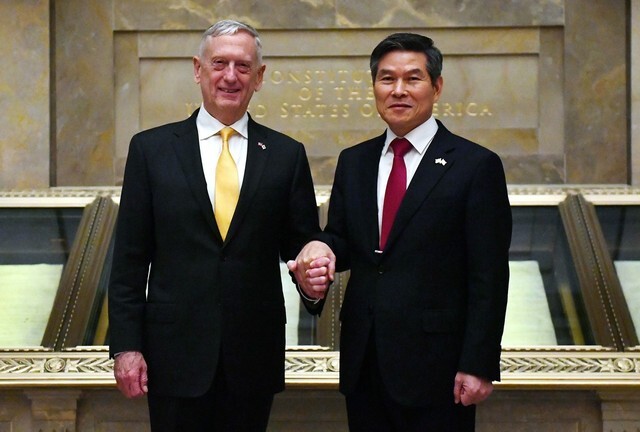hankyoreh
Links to other country sites 다른 나라 사이트 링크
Questions abound regarding OPCON transfer and CFC structure

The future structure of the Combined Forces Command (CFC) is drawing attention after South Korea and the US signed combined defense guideline for the establishment of a South Korean military-led combined command system following the transfer of operational wartime control (OPCON).
The new guideline was signed at the two sides’ 50th Security Consultative Meeting (SCM), which ended on Oct. 31.
The combined defense guideline specifies that US Forces Korea (USFK) is to remain stationed on the Korean Peninsula even after the OPCON transfer, with the CFC system to remain in place. The declaration was made to allay concerns in some quarters that the OPCON handover may lead to USFK’s withdrawal or CFC’s dismantling, the South Korean Ministry of National Defense (MND) explained.
The future CFC is to receive strategic directions and operational guidelines from a military consultative body receiving joint guidelines from the commanders-in-chief (presidents) of the South Korea and US armed forces. The consultative body in question in this case is believed to refer to the SCM and Military Committee Meeting (MCM). It can be described as a system in which decisions by the two sides’ commanders-in-chief are carried out over a process linking the SCM to the MCM and ultimately CFC.
The future CFC is to be commanded by a general from the South Korean armed forces, with a US general serving as deputy commander. The case has been mentioned as the only exception to the so-called “Pershing rule,” which holds that the US military does not assign command authority to a member of another country’s armed forces. The assignment of generals as deputy commander as well as commander is meant to maximize the US military’s wartime mobilization capabilities, the ministry explained.
Issue of S. Korea’s ability to command US strategic assets
Some observers have questioned whether the South Korean CFC commander would be able to actually command US military strategic assets such as aircraft carriers or strategic bombers. As reasons, they have cited the South Korean military’s utter lack of command experience with strategic assets, while predicting that the US military is unlikely to be willing to hand over command authority.
A memorandum for record on the future command structure that was approved alongside the combined defense guideline states that the South Korean military is to command the Army and Navy among CFC’s component armed forces commands, while the US military is to command the Air Force. A Ministry of National Defense official gave an ambiguous response on the issue, stating that “the CFC commander is entrusted with authority from the South Korean and US military commanders-in-chief to exercise command authority” but adding that “related discussions are currently under way.”
Also at the SCM, South Korea and the US approved an agreement defining the relationship among the Joint Chiefs of Staff, CFC, and UN Command. Central to it was a framework keeping the UN Command in place as well as CFC after the OPCON transfer. But analysts are predicting inevitable changes to the UN Command’s standing as progress is made in denuclearization/peace regime negotiations and the armistice agreement is replaced with a peace agreement.
By Yoo Kang-moon, senior staff writer
Please direct comments or questions to [english@hani.co.kr]

Editorial・opinion
![[Column] Park Geun-hye déjà vu in Yoon Suk-yeol [Column] Park Geun-hye déjà vu in Yoon Suk-yeol](https://flexible.img.hani.co.kr/flexible/normal/500/300/imgdb/original/2024/0424/651713945113788.jpg) [Column] Park Geun-hye déjà vu in Yoon Suk-yeol
[Column] Park Geun-hye déjà vu in Yoon Suk-yeol![[Editorial] New weight of N. Korea’s nuclear threats makes dialogue all the more urgent [Editorial] New weight of N. Korea’s nuclear threats makes dialogue all the more urgent](https://flexible.img.hani.co.kr/flexible/normal/500/300/imgdb/original/2024/0424/7317139454662664.jpg) [Editorial] New weight of N. Korea’s nuclear threats makes dialogue all the more urgent
[Editorial] New weight of N. Korea’s nuclear threats makes dialogue all the more urgent- [Guest essay] The real reason Korea’s new right wants to dub Rhee a founding father
- [Column] ‘Choson’: Is it time we start referring to N. Korea in its own terms?
- [Editorial] Japan’s rewriting of history with Korea has gone too far
- [Column] The president’s questionable capacity for dialogue
- [Column] Are chaebol firms just pizza pies for families to divvy up as they please?
- [Column] Has Korea, too, crossed the Rubicon on China?
- [Correspondent’s column] In Japan’s alliance with US, echoes of its past alliances with UK
- [Editorial] Does Yoon think the Korean public is wrong?
Most viewed articles
- 1‘We must say no’: Seoul defense chief on Korean, USFK involvement in hypothetical Taiwan crisis
- 2[Reportage] On US campuses, student risk arrest as they call for divestment from Israel
- 3[Column] Park Geun-hye déjà vu in Yoon Suk-yeol
- 4‘Weddingflation’ breaks the bank for Korean couples-to-be
- 5Korea sees more deaths than births for 52nd consecutive month in February
- 6N. Korean delegation’s trip to Iran shows how Pyongyang is leveraging ties with Moscow
- 7Amnesty notes ‘erosion’ of freedom of expression in Korea in annual human rights report
- 8Will NewJeans end up collateral damage in internal feud at K-pop juggernaut Hybe?
- 9N. Korean hackers breached 10 defense contractors in South for months, police say
- 10[Guest essay] The real reason Korea’s new right wants to dub Rhee a founding father